Poole Ch.P., Jr. Handbook of Superconductivity
Подождите немного. Документ загружается.

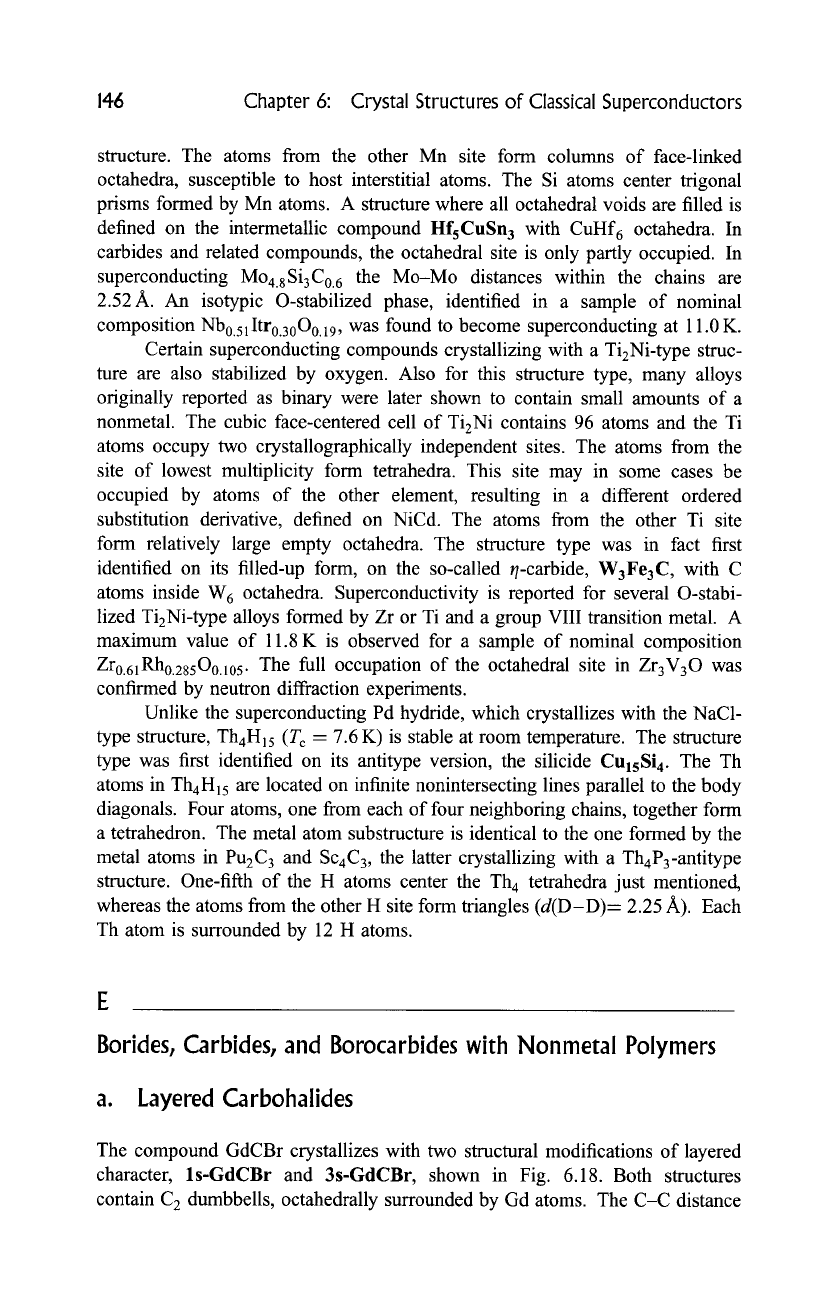
146 Chapter 6: Crystal Structures of Classical Superconductors
structure. The atoms from the other Mn site form columns of face-linked
octahedra, susceptible to host interstitial atoms. The Si atoms center trigonal
prisms formed by Mn atoms. A structure where all octahedral voids are filled is
defined on the intermetallic compound l-IfsCuSn 3 with CuHf 6 octahedra. In
carbides and related compounds, the octahedral site is only partly occupied. In
superconducting M04.8Si3C0. 6 the Mo-Mo distances within the chains are
2.52A. An isotypic O-stabilized phase, identified in a sample of nominal
composition Nbo.s1Itro.3000.19 , was found to become superconducting at 11.0 K.
Certain superconducting compounds crystallizing with a Ti2Ni-type struc-
ture are also stabilized by oxygen. Also for this structure type, many alloys
originally reported as binary were later shown to contain small amounts of a
nonmetal. The cubic face-centered cell of Ti2Ni contains 96 atoms and the Ti
atoms occupy two crystallographically independent sites. The atoms from the
site of lowest multiplicity form tetrahedra. This site may in some cases be
occupied by atoms of the other element, resulting in a different ordered
substitution derivative, defined on NiCd. The atoms from the other Ti site
form relatively large empty octahedra. The structure type was in fact first
identified on its filled-up form, on the so-called q-carbide, W3Fe3C , with C
atoms inside W 6 octahedra. Superconductivity is reported for several O-stabi-
lized Ti2Ni-type alloys formed by Zr or Ti and a group VIII transition metal. A
maximum value of 11.8 K is observed for a sample of nominal composition
Zro.61Rho.28500.105. The full occupation of the octahedral site in Zr3V30 was
confirmed by neutron diffraction experiments.
Unlike the superconducting Pd hydride, which crystallizes with the NaC1-
type structure, Th4H15 (T c = 7.6 K) is stable at room temperature. The structure
type was first identified on its antitype version, the silicide CUlsSi 4. The Th
atoms in ThaH15 are located on infinite nonintersecting lines parallel to the body
diagonals. Four atoms, one from each of four neighboring chains, together form
a tetrahedron. The metal atom substructure is identical to the one formed by the
metal atoms in Pu2C 3 and
5c4C3,
the latter crystallizing with a Th4P3-antitype
structure. One-fifth of the H atoms center the Th 4 tetrahedra just mentioned,
whereas the atoms from the other H site form triangles (d(D-D)= 2.25 A). Each
Th atom is surrounded by 12 H atoms.
Borides, Carbides, and Borocarbides with Nonmetal Polymers
a. Layered Carbohalides
The compound GdCBr crystallizes with two structural modifications of layered
character, ls-GdCBr and 3s-GdCBr, shown in Fig. 6.18. Both structures
contain C 2 dumbbells, octahedrally surrounded by Gd atoms. The C-C distance
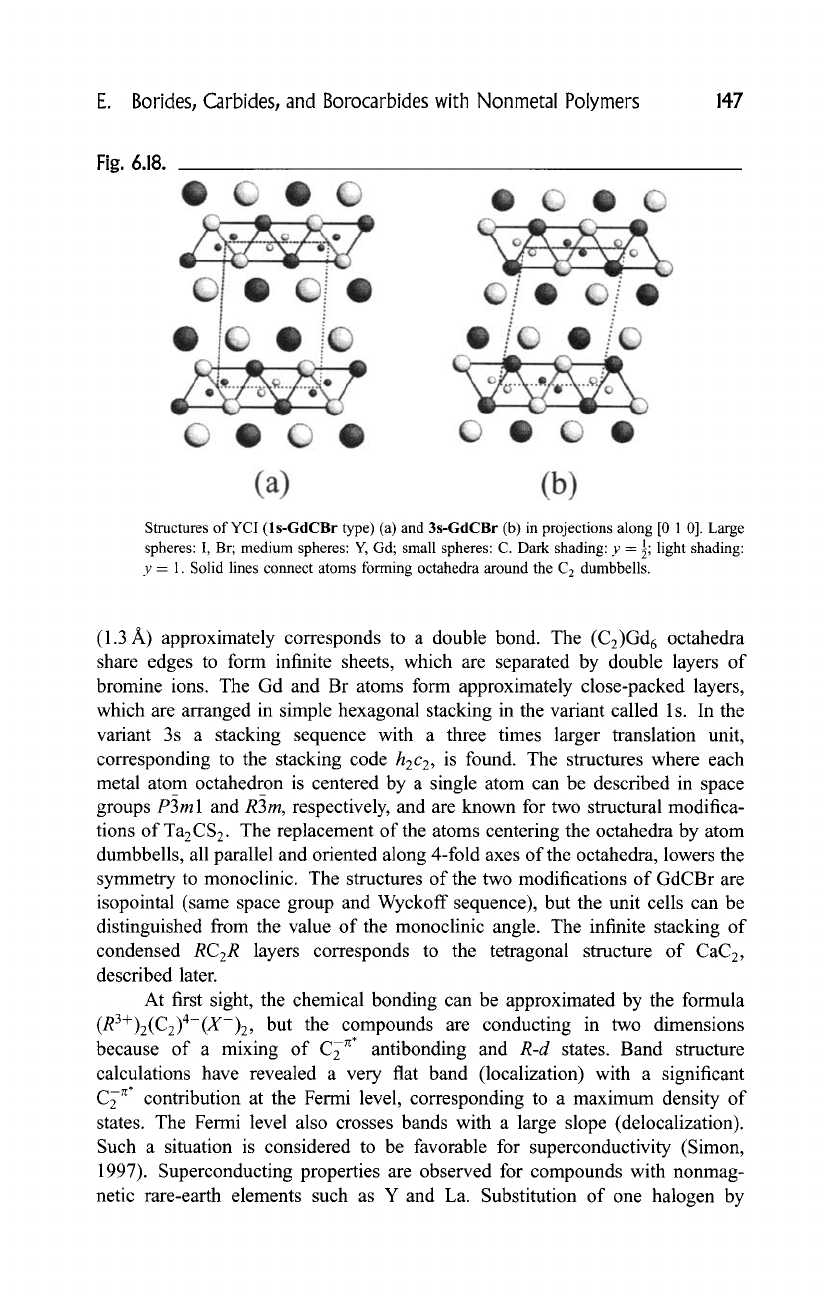
E. Borides, Carbides, and Borocarbides with Nonmetal Polymers 147
Fig.
6.18.
Structures ofYCI (ls-GdCBr type) (a) and 3s-GdCBr (b) in projections along [0 1 0]. Large
spheres: I, Br; medium spheres: Y, Gd; small spheres: C. Dark shading: y -- 89 light shading:
y -- 1. Solid lines connect atoms forming octahedra around the C 2 dumbbells.
(1.3 A) approximately corresponds to a double bond. The (C2)Gd 6 octahedra
share edges to form infinite sheets, which are separated by double layers of
bromine ions. The Gd and Br atoms form approximately close-packed layers,
which are arranged in simple hexagonal stacking in the variant called l s. In the
variant 3s a stacking sequence with a three times larger translation unit,
corresponding to the stacking code
h2c2,
is
found. The structures where each
metal atom octahedron is centered by a single atom can be described in space
groups
P~3m
1 and
R~3m,
respectively, and are known for two structural modifica-
tions of TazCS 2. The replacement of the atoms centering the octahedra by atom
dumbbells, all parallel and oriented along 4-fold axes of the octahedra, lowers the
symmetry to monoclinic. The structures of the two modifications of GdCBr are
isopointal (same space group and Wyckoff sequence), but the unit cells can be
distinguished from the value of the monoclinic angle. The infinite stacking of
condensed
RCzR
layers corresponds to the tetragonal structure of CaC2,
described later.
At first sight, the chemical bonding can be approximated by the formula
(R3+)2(Cz)4-(X-)2,
but the compounds are conducting in two dimensions
because of a mixing of C 2 antibonding and
R-d
states. Band structure
calculations have revealed a very flat band (localization) with a significant
C2 ~* contribution at the Fermi level, corresponding to a maximum density of
states. The Fermi level also crosses bands with a large slope (delocalization).
Such a situation is considered to be favorable for superconductivity (Simon,
1997). Superconducting properties are observed for compounds with nonmag-
netic rare-earth elements such as Y and La. Substitution of one halogen by
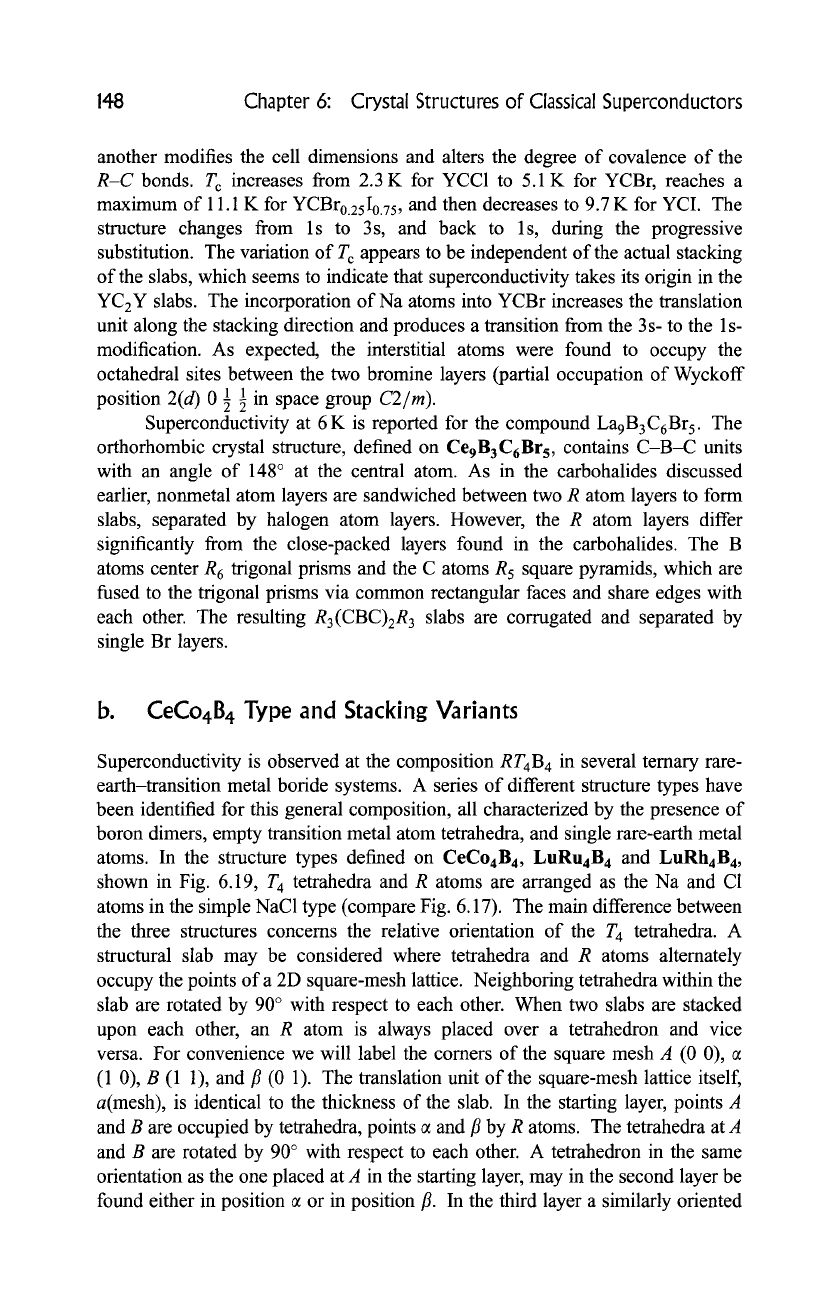
148 Chapter 6: Crystal Structures of Classical Superconductors
another modifies the cell dimensions and alters the degree of covalence of the
R-C
bonds. T c increases from 2.3 K for YCC1 to 5.1 K for YCBr, reaches a
maximum of 11.1 K for YCBr0.2510.75, and then decreases to 9.7 K for YCI. The
structure changes from ls to 3s, and back to ls, during the progressive
substitution. The variation of T c appears to be independent of the actual stacking
of the slabs, which seems to indicate that superconductivity takes its origin in the
YC2Y slabs. The incorporation of Na atoms into YCBr increases the translation
unit along the stacking direction and produces a transition from the 3s- to the Is-
modification. As expected, the interstitial atoms were found to occupy the
octahedral sites between the two bromine layers (partial occupation of Wyckoff
position 2(d) 0 1 89 in space group
C2/m).
Superconductivity at 6 K is reported for the compound La9B3C6Br 5. The
orthorhombic crystal structure, defined on Ce9B3C6Brs, contains C-B-C units
with an angle of 148 ~ at the central atom. As in the carbohalides discussed
earlier, nonmetal atom layers are sandwiched between two R atom layers to form
slabs, separated by halogen atom layers. However, the R atom layers differ
significantly from the close-packed layers found in the carbohalides. The B
atoms center R 6 trigonal prisms and the C atoms R 5 square pyramids, which are
fused to the trigonal prisms via common rectangular faces and share edges with
each other. The resulting R3(CBC)zR3 slabs are corrugated and separated by
single Br layers.
b.
CeCo4B 4
Type and Stacking Variants
Superconductivity is observed at the composition RT4B 4 in several temary rare-
earth-transition metal boride systems. A series of different structure types have
been identified for this general composition, all characterized by the presence of
boron dimers, empty transition metal atom tetrahedra, and single rare-earth metal
atoms. In the structure types defined on CeCo4B4, LuRu4B 4 and LuRh4B4,
shown in Fig. 6.19, T 4 tetrahedra and R atoms are arranged as the Na and C1
atoms in the simple NaC1 type (compare Fig. 6.17). The main difference between
the three structures concems the relative orientation of the T 4 tetrahedra. A
structural slab may be considered where tetrahedra and R atoms altemately
occupy the points of a 2D square-mesh lattice. Neighboring tetrahedra within the
slab are rotated by 90 ~ with respect to each other. When two slabs are stacked
upon each other, an R atom is always placed over a tetrahedron and vice
versa. For convenience we will label the comers of the square mesh A (0 0),
(1 0), B (1 1), and fl (0 1). The translation unit of the square-mesh lattice itself,
a(mesh), is identical to the thickness of the slab. In the starting layer, points A
and B are occupied by tetrahedra, points ~ and fl by R atoms. The tetrahedra at A
and B are rotated by 90 ~ with respect to each other. A tetrahedron in the same
orientation as the one placed at A in the starting layer, may in the second layer be
found either in position ~ or in position ft. In the third layer a similarly oriented
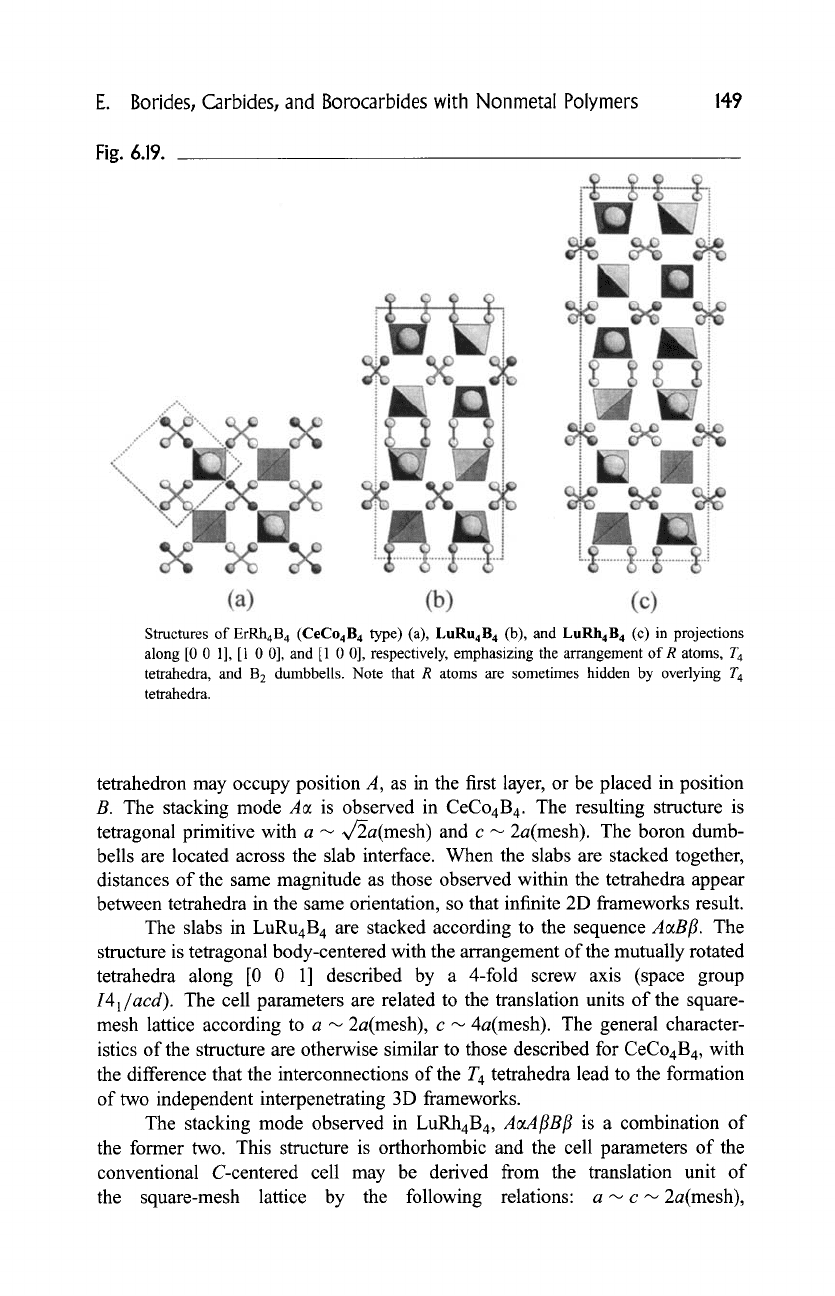
E. Borides, Carbides, and Borocarbides with Nonmetal Polymers 149
Fig. 639.
Structures of ErRh4B 4 (CeCo4B 4 type) (a), LuRu4B 4 (b), and LuRh4B 4 (c) in projections
along [0 0 1], [1 0 0], and [1 0 0], respectively, emphasizing the arrangement of R atoms, T 4
tetrahedra, and B 2 dumbbells. Note that R atoms are sometimes hidden by overlying T 4
tetrahedra.
tetrahedron may occupy position A, as in the first layer, or be placed in position
B. The stacking mode Aa is observed in CeCo4B4 . The resulting structure is
tetragonal primitive with a-~ ~/2a(mesh) and c ~ 2a(mesh). The boron dumb-
bells are located across the slab interface. When the slabs are stacked together,
distances of the same magnitude as those observed within the tetrahedra appear
between tetrahedra in the same orientation, so that infinite 2D frameworks result.
The slabs in LuRu4B 4 are stacked according to the sequence
AczBfl.
The
structure is tetragonal body-centered with the arrangement of the mutually rotated
tetrahedra along [0 0 1] described by a 4-fold screw axis (space group
I41/acd ).
The cell parameters are related to the translation units of the square-
mesh lattice according to a-~ 2a(mesh), c ~ 4a(mesh). The general character-
istics of the structure are otherwise similar to those described for CeCo4B 4, with
the difference that the interconnections of the T 4 tetrahedra lead to the formation
of two independent interpenetrating 3D frameworks.
The stacking mode observed in LuRh4B 4,
AaAflBfl
is a combination of
the former two. This structure is orthorhombic and the cell parameters of the
conventional C-centered cell may be derived from the translation unit of
the square-mesh lattice by the following relations: a~ c~ 2a(mesh),
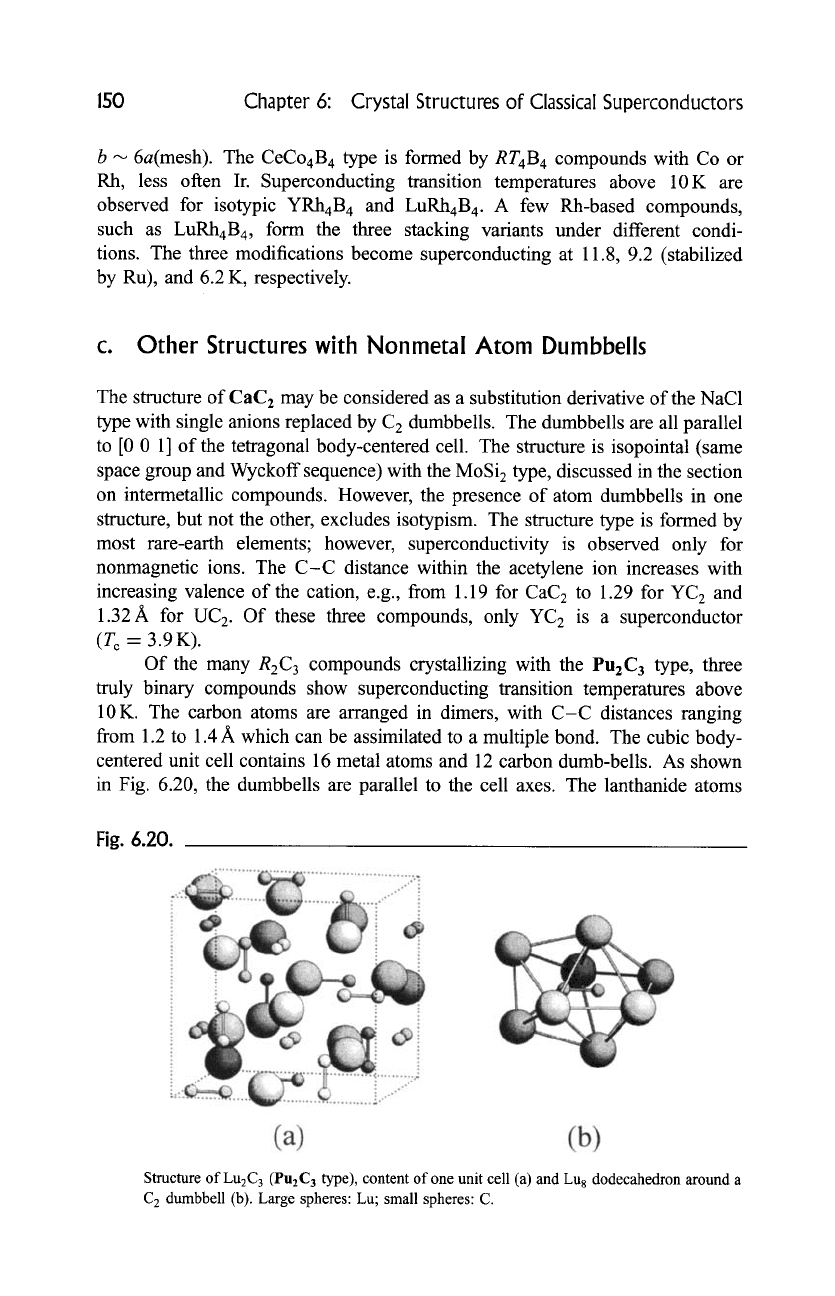
150
Chapter 6: Crystal Structures of Classical Superconductors
b--~ 6a(mesh). The CeCo4B 4 type is formed by RT4B 4 compounds with Co or
Rh, less often Ir. Superconducting transition temperatures above 10K are
observed for isotypic YRh4B 4 and LuRhaB 4. A few Rh-based compounds,
such as LuRhaB4, form the three stacking variants under different condi-
tions. The three modifications become superconducting at 11.8, 9.2 (stabilized
by Ru), and 6.2 K, respectively.
c. Other Structures with Nonmetal Atom Dumbbells
The structure of CaCz may be considered as a substitution derivative of the NaC1
type with single anions replaced by C2 dumbbells. The dumbbells are all parallel
to [0 0 1] of the tetragonal body-centered cell. The structure is isopointal (same
space group and Wyckoff sequence) with the MoSi 2 type, discussed in the section
on intermetallic compounds. However, the presence of atom dumbbells in one
structure, but not the other, excludes isotypism. The structure type is formed by
most rare-earth elements; however, superconductivity is observed only for
nonmagnetic ions. The C-C distance within the acetylene ion increases with
increasing valence of the cation, e.g., from 1.19 for CaC 2 to 1.29 for YC 2 and
1.32A for UC2. Of these three compounds, only YC2 is a superconductor
(T c = 3.9 K).
Of the many R2C 3 compounds crystallizing with the Pu2C 3 type, three
truly binary compounds show superconducting transition temperatures above
10 K. The carbon atoms are arranged in dimers, with C-C distances ranging
from 1.2 to 1.4 A which can be assimilated to a multiple bond. The cubic body-
centered unit cell contains 16 metal atoms and 12 carbon dumb-bells. As shown
in Fig. 6.20, the dumbbells are parallel to the cell axes. The lanthanide atoms
Fig. 6.20.
Structure ofLu2C 3 (Pu2C 3 type), content of one unit cell (a) and Lu 8 dodecahedron around a
C 2 dumbbell (b). Large spheres: Lu; small spheres: C.
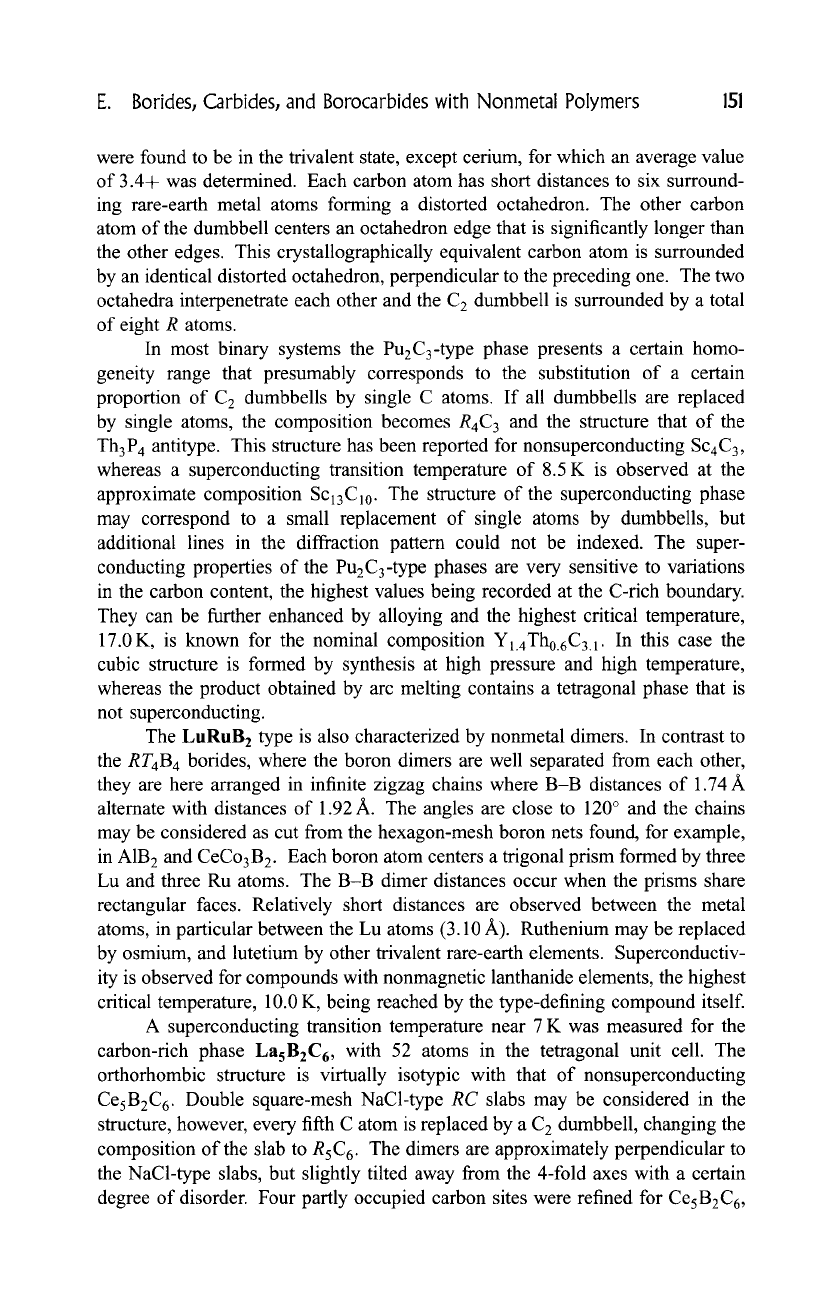
E. Borides, Carbides, and Borocarbides with Nonmetal Polymers ISI
were found to be in the trivalent state, except cerium, for which an average value
of 3.4+ was determined. Each carbon atom has short distances to six surround-
ing rare-earth metal atoms forming a distorted octahedron. The other carbon
atom of the dumbbell centers an octahedron edge that is significantly longer than
the other edges. This crystallographically equivalent carbon atom is surrounded
by an identical distorted octahedron, perpendicular to the preceding one. The two
octahedra interpenetrate each other and the C 2 dumbbell is surrounded by a total
of eight R atoms.
In most binary systems the PuzC3-type phase presents a certain homo-
geneity range that presumably corresponds to the substitution of a certain
proportion of C2 dumbbells by single C atoms. If all dumbbells are replaced
by single atoms, the composition becomes R4C 3 and the structure that of the
Th3P 4 antitype. This structure has been reported for nonsuperconducting Sc4C 3,
whereas a superconducting transition temperature of 8.5 K is observed at the
approximate composition Sc13C10 . The structure of the superconducting phase
may correspond to a small replacement of single atoms by dumbbells, but
additional lines in the diffraction pattern could not be indexed. The super-
conducting properties of the PuzC3-type phases are very sensitive to variations
in the carbon content, the highest values being recorded at the C-rich boundary.
They can be further enhanced by alloying and the highest critical temperature,
17.0 K, is known for the nominal composition Y1.4Th0.6C3.1. In this case the
cubic structure is formed by synthesis at high pressure and high temperature,
whereas the product obtained by arc melting contains a tetragonal phase that is
not superconducting.
The LuRuB2 type is also characterized by nonmetal dimers. In contrast to
the RT4B 4 borides, where the boron dimers are well separated from each other,
they are here arranged in infinite zigzag chains where B-B distances of 1.74/~
alternate with distances of 1.92)~. The angles are close to 120 ~ and the chains
may be considered as cut from the hexagon-mesh boron nets found, for example,
in A1B 2 and CeCo 3 B 2. Each boron atom centers a trigonal prism formed by three
Lu and three Ru atoms. The B-B dimer distances occur when the prisms share
rectangular faces. Relatively short distances are observed between the metal
atoms, in particular between the Lu atoms (3.10 A). Ruthenium may be replaced
by osmium, and lutetium by other trivalent rare-earth elements. Superconductiv-
ity is observed for compounds with nonmagnetic lanthanide elements, the highest
critical temperature, 10.0 K, being reached by the type-defining compound itself.
A superconducting transition temperature near 7 K was measured for the
carbon-rich phase LasB2C 6, with 52 atoms in the tetragonal unit cell. The
orthorhombic structure is virtually isotypic with that of nonsuperconducting
CesBzC 6. Double square-mesh NaCl-type
RC
slabs may be considered in the
structure, however, every fifth C atom is replaced by a C2 dumbbell, changing the
composition of the slab to R5C 6. The dimers are approximately perpendicular to
the NaCl-type slabs, but slightly tilted away from the 4-fold axes with a certain
degree of disorder. Four partly occupied carbon sites were refined for CesB2C6,
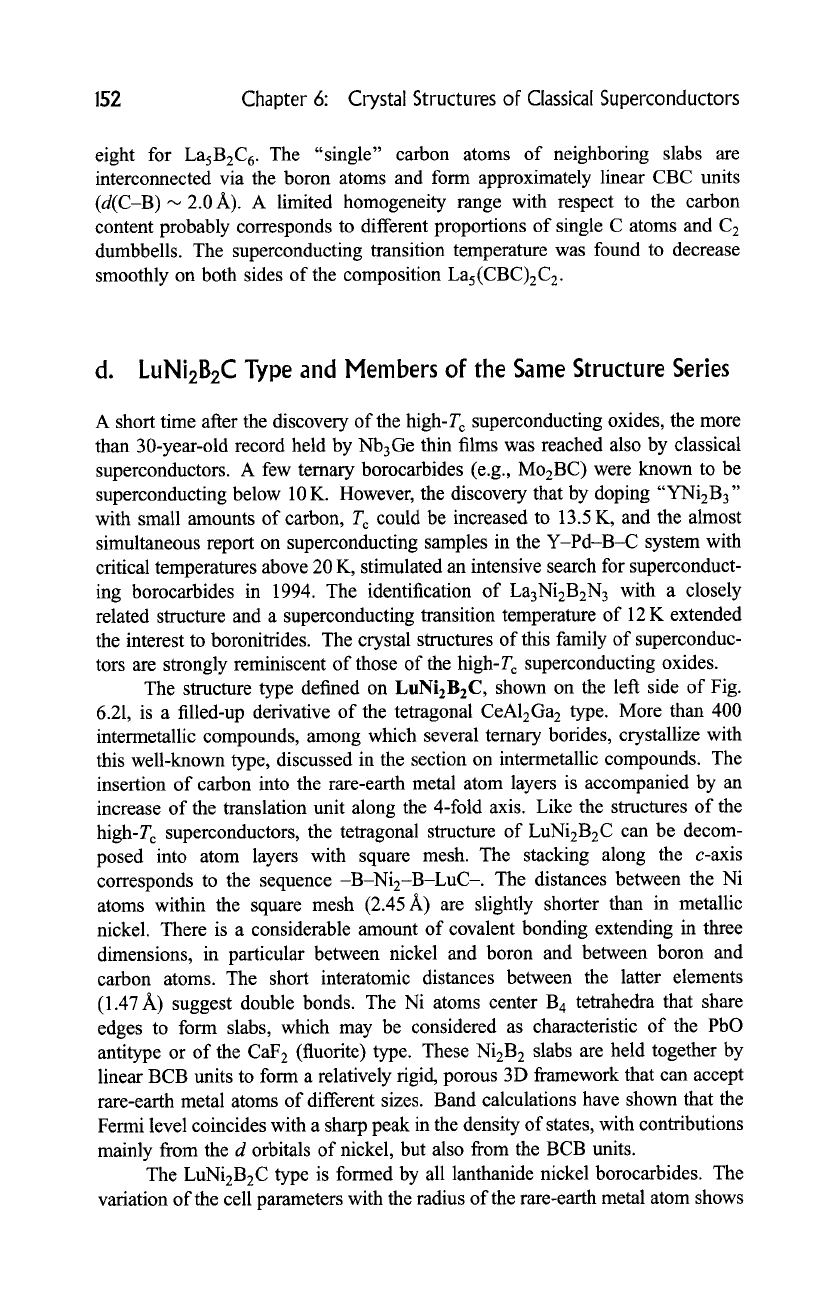
152
Chapter 6: Crystal Structures of Classical Superconductors
eight for LasB2C 6. The "single" carbon atoms of neighboring slabs are
interconnected via the boron atoms and form approximately linear CBC units
(d(C-B) ~ 2.0A). A limited homogeneity range with respect to the carbon
content probably corresponds to different proportions of single C atoms and C2
dumbbells. The superconducting transition temperature was found to decrease
smoothly on both sides of the composition Las(CBC)2C 2.
d. LuNi2B2C Type and Members of the Same Structure Series
A short time aiter the discovery of the high-T c superconducting oxides, the more
than 30-year-old record held by Nb3Ge thin films was reached also by classical
superconductors. A few temary borocarbides (e.g., Mo2BC) were known to be
superconducting below 10 K. However, the discovery that by doping "YNizB3"
with small amounts of carbon, Tc could be increased to 13.5 K, and the almost
simultaneous report on superconducting samples in the Y-Pd-B-C system with
critical temperatures above 20 K, stimulated an intensive search for superconduct-
ing borocarbides in 1994. The identification of La3Ni2BzN3 with a closely
related structure and a superconducting transition temperature of 12 K extended
the interest to boronitrides. The crystal structures of this family of superconduc-
tors are strongly reminiscent of those of the high-Tr superconducting oxides.
The structure type defined on LuNi2B2C, shown on the left side of Fig.
6.21, is a filled-up derivative of the tetragonal CeA12Ga 2 type. More than 400
intermetallic compounds, among which several temary borides, crystallize with
this well-known type, discussed in the section on intermetallic compounds. The
insertion of carbon into the rare-earth metal atom layers is accompanied by an
increase of the translation unit along the 4-fold axis. Like the structures of the
high-T c superconductors, the tetragonal structure of LuNi2B2C can be decom-
posed into atom layers with square mesh. The stacking along the c-axis
corresponds to the sequence-B-Ni2-B-LuC-. The distances between the Ni
atoms within the square mesh (2.45 A) are slightly shorter than in metallic
nickel. There is a considerable amount of covalent bonding extending in three
dimensions, in particular between nickel and boron and between boron and
carbon atoms. The short interatomic distances between the latter elements
(1.47 A) suggest double bonds. The Ni atoms center B 4 tetrahedra that share
edges to form slabs, which may be considered as characteristic of the PbO
antitype or of the CaF 2 (fluorite) type. These Ni2B 2 slabs are held together by
linear BCB units to form a relatively rigid, porous 3D framework that can accept
rare-earth metal atoms of different sizes. Band calculations have shown that the
Fermi level coincides with a sharp peak in the density of states, with contributions
mainly from the d orbitals of nickel, but also from the BCB units.
The LuNi2B2C type is formed by all lanthanide nickel borocarbides. The
variation of the cell parameters with the radius of the rare-earth metal atom shows
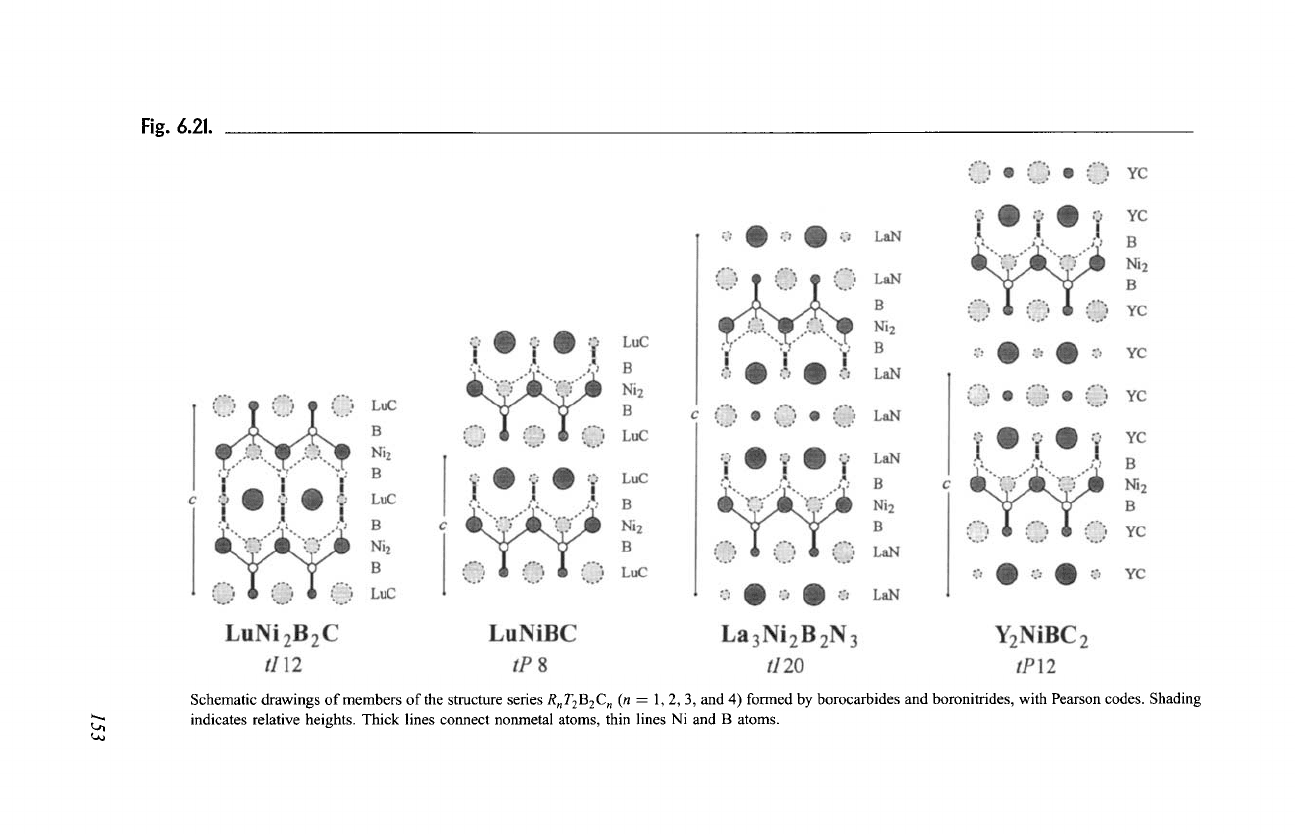
Fig. 6.21.
Schematic drawings of members of the structure series
RnT2B2C n
(n = 1,2, 3, and 4) formed by borocarbides and boronitrides, with Pearson codes. Shading
indicates relative heights. Thick lines connect nonmetal atoms, thin lines Ni and B atoms.
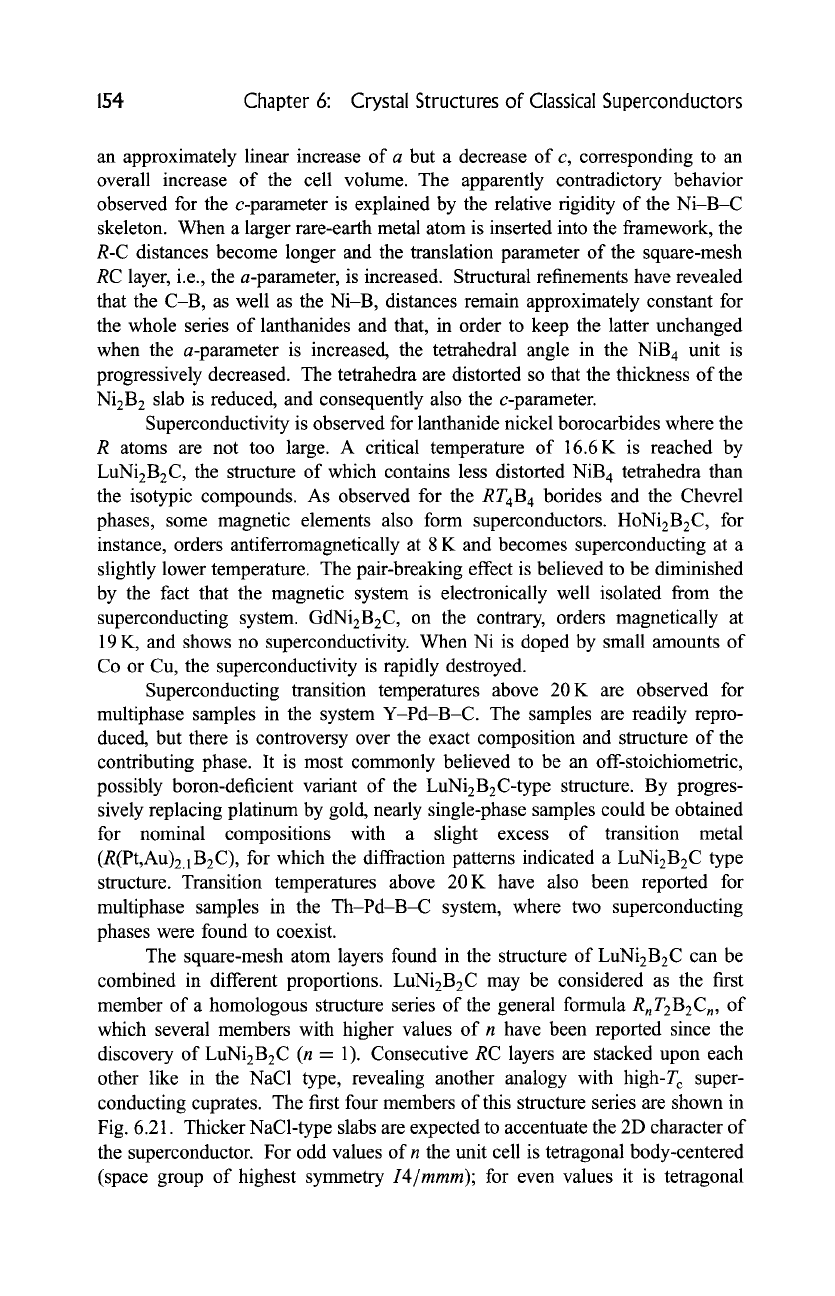
154 Chapter 6: Crystal Structures of Classical Superconductors
an approximately linear increase of a but a decrease of c, corresponding to an
overall increase of the cell volume. The apparently contradictory behavior
observed for the c-parameter is explained by the relative rigidity of the Ni-B-C
skeleton. When a larger rare-earth metal atom is inserted into the framework, the
R-C distances become longer and the translation parameter of the square-mesh
RC layer, i.e., the a-parameter, is increased. Structural refinements have revealed
that the C-B, as well as the Ni-B, distances remain approximately constant for
the whole series of lanthanides and that, in order to keep the latter unchanged
when the a-parameter is increased, the tetrahedral angle in the NiB 4 unit is
progressively decreased. The tetrahedra are distorted so that the thickness of the
Ni2B 2 slab is reduced, and consequently also the c-parameter.
Superconductivity is observed for lanthanide nickel borocarbides where the
R atoms are not too large. A critical temperature of 16.6K is reached by
LuNi2B2C, the structure of which contains less distorted NiB 4 tetrahedra than
the isotypic compounds. As observed for the RT4B 4 borides and the Chevrel
phases, some magnetic elements also form superconductors. HoNi2B2C, for
instance, orders antiferromagnetically at 8 K and becomes superconducting at a
slightly lower temperature. The pair-breaking effect is believed to be diminished
by the fact that the magnetic system is electronically well isolated from the
superconducting system. GdNi2B2C, on the contrary, orders magnetically at
19 K, and shows no superconductivity. When Ni is doped by small amounts of
Co or Cu, the superconductivity is rapidly destroyed.
Superconducting transition temperatures above 20K are observed for
multiphase samples in the system Y-Pd-B-C. The samples are readily repro-
duced, but there is controversy over the exact composition and structure of the
contributing phase. It is most commonly believed to be an off-stoichiometric,
possibly boron-deficient variant of the LuNizBzC-type structure. By progres-
sively replacing platinum by gold, nearly single-phase samples could be obtained
for nominal compositions with a slight excess of transition metal
(R(Pt,Au)z.IB2C), for which the diffraction patterns indicated a LuNizBzC type
structure. Transition temperatures above 20K have also been reported for
multiphase samples in the Th-Pd-B-C system, where two superconducting
phases were found to coexist.
The square-mesh atom layers found in the structure of LuNizBzC can be
combined in different proportions. LuNi2BzC may be considered as the first
member of a homologous structure series of the general formula
RnTzBzCn,
of
which several members with higher values of n have been reported since the
discovery of LuNizBzC (n = 1). Consecutive RC layers are stacked upon each
other like in the NaC1 type, revealing another analogy with high-T~ super-
conducting cuprates. The first four members of this structure series are shown in
Fig. 6.21. Thicker NaCl-type slabs are expected to accentuate the 2D character of
the superconductor. For odd values of n the unit cell is tetragonal body-centered
(space group of highest symmetry
I4/mmm);
for even values it is tetragonal
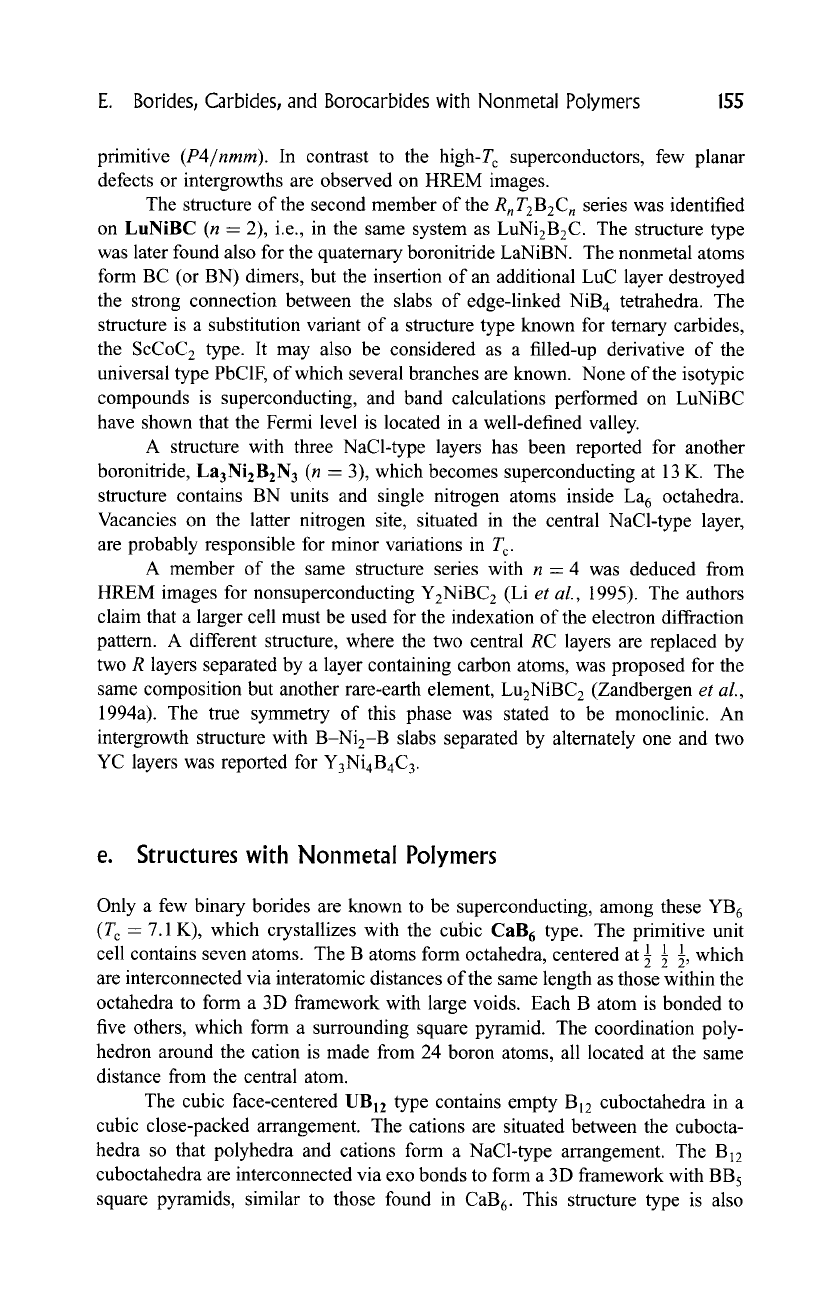
E. Borides, Carbides, and Borocarbides with Nonmetal Polymers 155
primitive
(P4/nmm).
In contrast to the high-To superconductors, few planar
defects or intergrowths are observed on HREM images.
The structure of the second member of the
RnTzBzC n
series was identified
on LuNiBC (n -- 2), i.e., in the same system as LuNizBzC. The structure type
was later found also for the quaternary boronitride LaNiBN. The nonmetal atoms
form BC (or BN) dimers, but the insertion of an additional LuC layer destroyed
the strong connection between the slabs of edge-linked NiB 4 tetrahedra. The
structure is a substitution variant of a structure type known for ternary carbides,
the ScCoC2 type. It may also be considered as a filled-up derivative of the
universal type PbC1E of which several branches are known. None of the isotypic
compounds is superconducting, and band calculations performed on LuNiBC
have shown that the Fermi level is located in a well-defined valley.
A structure with three NaCl-type layers has been reported for another
boronitride, La3Ni2B2N 3 (n = 3), which becomes superconducting at 13 K. The
structure contains BN units and single nitrogen atoms inside La 6 octahedra.
Vacancies on the latter nitrogen site, situated in the central NaCl-type layer,
are probably responsible for minor variations in T~.
A member of the same structure series with n = 4 was deduced from
HREM images for nonsuperconducting Y2NiBC2 (Li
et aL,
1995). The authors
claim that a larger cell must be used for the indexation of the electron diffraction
pattern. A different structure, where the two central RC layers are replaced by
two R layers separated by a layer containing carbon atoms, was proposed for the
same composition but another rare-earth element, LuzNiBC 2 (Zandbergen
et al.,
1994a). The true symmetry of this phase was stated to be monoclinic. An
intergrowth structure with B-Niz-B slabs separated by alternately one and two
YC layers was reported for Y3Ni4B4C3.
e. Structures with Nonmetal Polymers
Only a few binary borides are known to be superconducting, among these YB 6
(T c --7.1 K), which crystallizes with the cubic CaB 6 type. The primitive unit
cell contains seven atoms. The B atoms form octahedra, centered at 1 1 89 which
are interconnected via interatomic distances of the same length as those within the
octahedra to form a 3D framework with large voids. Each B atom is bonded to
five others, which form a surrounding square pyramid. The coordination poly-
hedron around the cation is made from 24 boron atoms, all located at the same
distance from the central atom.
The cubic face-centered UB12 type contains empty B12 cuboctahedra in a
cubic close-packed arrangement. The cations are situated between the cubocta-
hedra so that polyhedra and cations form a NaCl-type arrangement. The
B12
cuboctahedra are interconnected via exo bonds to form a 3D framework with BB 5
square pyramids, similar to those found in CaB 6. This structure type is also
